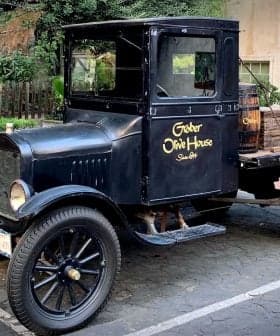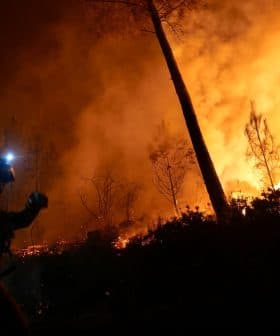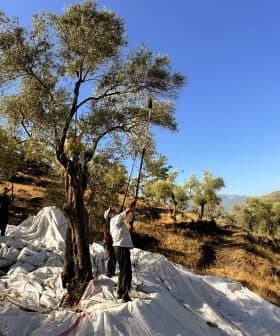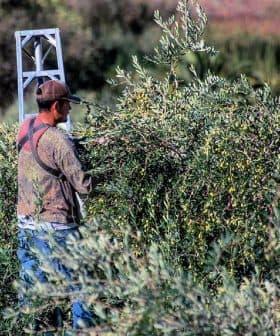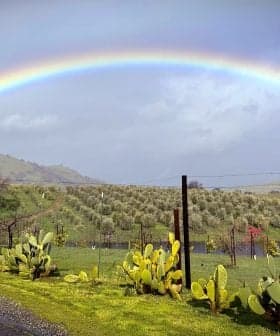After Wildfires, California Producers Find Inspiration in Harvest
California olive growers discuss this year's expected yields, as well as the challenges and rewards of their work.
 McEvoy Ranch
McEvoy RanchCalifornia olive growers are experiencing a successful harvest season, with companies like McEvoy Ranch, Corto Olive Co., Pacific Sun Farms, and Nick Sciabica & Sons expecting good yields. Despite the recent wildfires, these farmers are grateful that their harvests were unaffected, and they predict better than average quantities and quality of olive oil this year. The growers find deep pride and fulfillment in their work, with the end of harvest being compared to the satisfaction of completing a marathon and the joy of producing high-quality olive oil.
With the 2017 olive harvest in full swing California, Olive Oil Times asked Samantha Dorsey of McEvoy Ranch, Brady Whitlow of Corto Olive Co., Pablo Voitzuk of Pacific Sun Farms and Jon Sciabica of Nick Sciabica & Sons how it was going so far. The four companies are expecting good yields.
Those moments, for us who deeply love what we do, are almost as healing and powerful as olive oil itself.
Harvest is such an intense time, as the year’s entire efforts hinge on six to eight weeks of exhausting work. Yet it’s richly rewarding as well, the farmers told us. The love of the growers’ for their work was evident in their responses to this reporter.
While the aftermath of the wildfires that swept through Napa and Sonoma counties last month is all around, and nearly everyone knows someone who lost a home, these farmers fared alright.
“Thankfully, our olive harvest is unaffected by the fires. Our employees, too, are all safe and sound and grateful to the emergency responders who worked so incredibly hard during the fires. We have run a few trials with the UC Davis Olive Center, and fortunately, we have not tasted any off flavors in our olive oil this year due to the North Bay fires,” Dorsey said.

Samantha Dorsey of McEvoy Ranch
Pacific Sun Farms milled some third-party olives that were grown close to the fires, but Voitzuk expressed relief to discover that olives appeared more resistant to the effects of smoke exposure than grapes. “In this regard, as we know from experiences of some colleagues in Italy and now from our own, olives are not as vulnerable to this type of stress as grapes are.”
Overall, the growers predict relatively good to better than average yields this year. “It should be a strong crop for California in terms of total quantity and quality,” said Sciabica. “It’s much needed to meet the overwhelming demand. Americans seem to have an insatiable thirst for California olive oil.”
McEvoy Ranch anticipates 100 tons of fruit, while Pacific Sun Farms foresees 20,000 gallons of oil. Corto Olive estimates collecting 20,000 tons of fruit and producing 800,000 gallons of oil. Nick Sciabica & Sons hopes for 100,000 gallons of oil.
A major difficulty associated with harvest involves condensing the work into the brief timespan. “The challenge is always to make the best of the window of time that weather presents between the warm days of October and the cool days of mid-December, when we have a high risk of frost,” said Voitzuk. “Our milling takes place during those six to eight weeks. The pace is very intense since we want to mill each cultivar at its optimal moment and the time is so limited.”
Another weather-related harvest challenge is rain. “We do not harvest in the rain to avoid problems with our trees. Consequently, too many rain delays will slow us down. If we slow down too much, we run the risk of having a freeze event at the end of the harvest,” added Whitlow.
When asked about the non-monetary rewards of harvest, all four growers waxed eloquent. It was obvious they found deep pride in their work and consider it richly fulfilling. Whitlow compared the end of harvest to the satisfaction that comes after running a long race. “Like at the end of a marathon, we are happy with our accomplishment. We always convene to review the season with camaraderie and stories of challenges overcome. We sleep well knowing that we are good at what we do and are proud to be able to offer our olive oil to others.”
Dorsey expressed the excitement of seeing and tasting the end product of her team’s hard work. “Harvest is absolutely the most exciting and exhilarating time of year. To smell and taste the oil coming directly out of the vertical separator is always moving. All those little pieces of fruit that we have been tending all season now release their golden green oil in such a dramatic array of aromas and flavors.”
Voitzuk spoke of how the joy of making olive oil eclipsed all the hardships encountered during harvest. “After harvest, a great olive oil is made, which enables us to forget the negatives and fully reminds us of why we do this. A good thing has happened, and we’re part of it. Those moments, for us who deeply love what we do, are almost as healing and powerful as olive oil itself.”
Sciabica’s found inspiration in the long history of the fourth-generation family business: “People who buy our oil still tell stories of the first time they met my grandfather at a farmers market or in a restaurant kitchen. Ironically, it’s not about the olive oil at all, it’s about feeling proud to come into work every day.”


